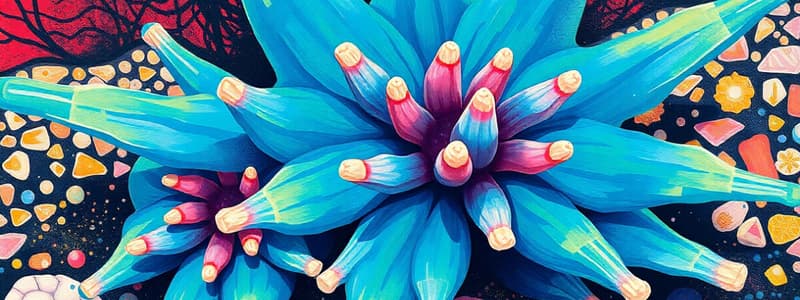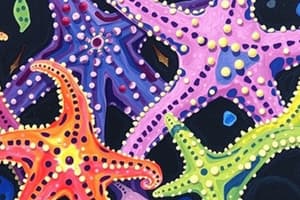Podcast
Questions and Answers
What is a characteristic feature of echinoderms?
What is a characteristic feature of echinoderms?
- They have endoskeletons made from rigid calcium carbonate plates. (correct)
- They possess an external skeleton made of chitin.
- They have a segmented body plan similar to arthropods.
- They are primarily freshwater organisms.
Which class includes organisms commonly referred to as starfish?
Which class includes organisms commonly referred to as starfish?
- Ophiuroidea
- Asteroidea (correct)
- Echinoidea
- Holothuroidea
How many species approximately belong to the class Ophiuroidea?
How many species approximately belong to the class Ophiuroidea?
- Roughly 5,000 species.
- Approximately 2,000 species. (correct)
- Around 1,000 species.
- About 10,000 species.
What distinguishes brittle stars from sea stars?
What distinguishes brittle stars from sea stars?
What are tiny sea daisies classified as?
What are tiny sea daisies classified as?
What characteristic of brittle stars allows them to escape from predators?
What characteristic of brittle stars allows them to escape from predators?
Which of the following is true regarding crinoids?
Which of the following is true regarding crinoids?
How do sand dollars and sea urchins differ in terms of physical characteristics?
How do sand dollars and sea urchins differ in terms of physical characteristics?
What is a significant feature of the water vascular system in echinoderms?
What is a significant feature of the water vascular system in echinoderms?
Which type of symmetry do adult echinoderms display?
Which type of symmetry do adult echinoderms display?
Which statement regarding the reproductive strategies of echinoderms is accurate?
Which statement regarding the reproductive strategies of echinoderms is accurate?
What unique ability do sea cucumbers possess for self-defense?
What unique ability do sea cucumbers possess for self-defense?
How do echinoderms primarily extract oxygen from water?
How do echinoderms primarily extract oxygen from water?
Which of the following echinoderm classes contains species known for having a hard outer shell?
Which of the following echinoderm classes contains species known for having a hard outer shell?
What common characteristic is shared among all echinoderms during their larval stage?
What common characteristic is shared among all echinoderms during their larval stage?
Flashcards are hidden until you start studying
Study Notes
Echinoderms
- Marine invertebrates with endoskeletons made of calcium carbonate plates
- About 7,000 species
- Found in benthic ecosystems, including intertidal zones, coral reefs, and deep ocean trenches
- Live in tropical, temperate, and colder waters
- Classified into five classes: Asteroidea, Ophiuroidea, Crinoidea, Echinoidea, and Holothuroidea
Class Asteroidea
- Includes sea stars (starfish)
- About 2,000 species
- Most species have five arms extending from a central disc
- Examples include: common starfish, purple sunstars, and sand stars
- Three species of tiny sea daisies are also in this class
- Sessile, resemble flowers or small sea anemones
- Live on submerged wood
Class Ophiuroidea
- Includes brittle stars
- About 2,000 species
- Have five arms radiating from a central disc
- Very flexible limbs
- Move by twisting motion of two arms
- Drop damaged or trapped arms
- Limbs regenerate quickly
- Examples: common brittle star, ruby brittle star, and great basket star
- Basket stars are a type of brittle star with branching arms
Class Crinoidea
- Includes crinoids (feather stars and sea lilies)
- Were abundant during the Mississippian Subperiod
- Only a few hundred species exist today
- Sessile echinoderms with feathery appendages that emerge from stalks
- Feather stars have up to 150 arms
- Can crawl or swim near the seafloor
- Many crinoids are sessile as adults
Class Echinoidea
- Includes sea urchins and sand dollars
- Over 900 species
- Have a hard outer shell called a test
- Sand dollars have short spines, sea urchins have longer, sharper spines
- Live at all depths in oceans
- Examples: long-spined urchin and keyhole urchin
Class Holothuroidea
- Includes sea cucumbers
- Roughly 1,200 species
- Range in size from less than one inch to over 6 feet in length
- Tapered, cylindrical bodies
- Have toxic internal organs they eject at predators
- Can regenerate their internal organs
- Can project hook-like structures from their skin
Echinoderm Movement
- Slow-moving (sea urchins, sea stars) or sessile (sea lilies, sea daisies)
- Use a water vascular system to move: water through canals and into tube feet
- Tube feet excrete sticky chemicals to adhere to surfaces and prey
- Brittle stars move quickly due to serpentine motion of limbs
- Start their lives as free-swimming larvae
- Some can swim as adults (sea cucumbers, feather stars )
Echinoderm Skin & Organs
- Thin layer of skin called an epidermis
- Spiny texture from bumps and ridges in the endoskeleton
- Sand dollars and sea urchins have true spines
- Sea cucumbers do not have plates, have tiny spicules embedded in their skin
- Loosely organized nervous system with a neural net
- Nerve ring encircles the mouth connected to radial nerves in the arms of sea stars and brittle stars
- No brains or eyes, can sense light and movement through eyespots
- Open circulatory systems
- Most lack organized respiratory systems: use tube feet to extract oxygen from water and tiny skin gills to bring in oxygen and release carbon dioxide
- Digestive systems vary: most have complete systems, sea stars excrete most waste through tube feet
Echinoderm Symmetry and Limbs
- Larvae exhibit bilateral symmetry
- Adult echinoderms exhibit pentaradial symmetry: five projections extending from a central point
- Arms extending from a central disc (sea stars)
- Feathery feeding tentacles (sea cucumbers)
- Tube feet also arranged in fives
Echinoderm Reproduction & Regeneration
- Reproduce sexually by producing eggs and sperm
- Some are hermaphrodites
- Some brood their eggs
- Other echinoderms produce free-floating or swimming larvae
- Brittle stars and sea stars regenerate limbs
- Can create entire organisms through fission
- Develop whole organisms if divided through their central discs
- Sea urchins and sea cucumbers also reproduce if divided in two
Echinoderm Diet
- Sea urchins are grazers
- Sea lilies and sea cucumbers use feeding tentacles
- Brittle stars collect small pieces of algae and animal matter with tube feet
- Sea stars are active predators: pursue sessile or slow-moving prey
- Attach to prey with tube feet
- Can pry open bivalve shells
- Turn their stomach inside out and insert it into the shell
- Excrete enzymes to digest prey
- Pull the stomach back into its body
Role of Echinoderms in Ecology
- Keystone species in many ecosystems
- Sand dollars and sea cucumbers oxygenate the seafloor
- Brittle stars, sea stars, and sea urchins are food sources
- Sea urchins keep algae growth in check
- Sea stars clean the seafloor by consuming dead animals
- Overpopulation can be problematic
- Overpopulation of purple sea urchins has decimated sea kelp beds
- Crown-of-thorns sea stars are voracious coral predators
Studying That Suits You
Use AI to generate personalized quizzes and flashcards to suit your learning preferences.



